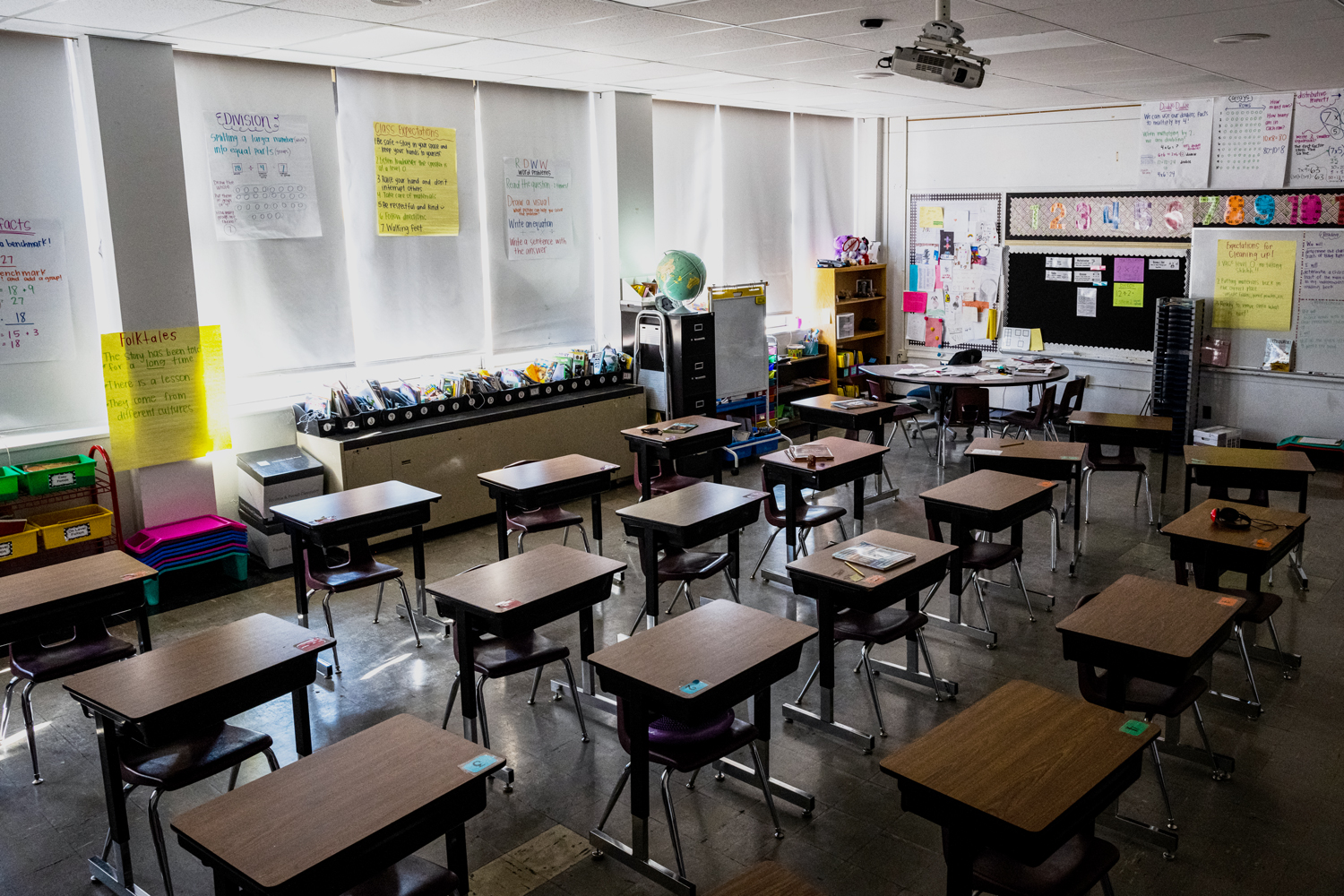Larry Moore doesn’t work in a school, but he knows why so many students skip class. On any given day, neighborhood kids relax in the chair and talk as he cuts their hair.
It’s hard to get moving in the morning when there’s nothing in the fridge, the children tell him. Nobody is making them go to school, they say. They feel like the teachers are constantly judging them. “They think I’m dirty, and I think they’re boring. Why spend year after year there if it doesn’t get me anywhere?” he hears.
“They tell me they get more gratification from almost anything else, even stealing a candy bar,” said Moore, a licensed barber and barbershop owner who volunteers his time giving free haircuts and hygiene guidance at the Mary Nelson Youth Center on the south side of Syracuse, New York.
“I always tell them—people will help you, but you gotta want more for yourself.”
Syracuse, with about 150,000 residents, is identified by the U.S. Census Bureau as one of the poorest cities in the Northeast, if not the nation.
Low incomes and high crime rates correlate with the local school district’s chronic student absenteeism problem.
A little more than half of the district’s students missed 10 percent or more of instruction time in 2023—or at least 18 of 180 school days in one academic year.
Moore said he thinks that low morale among parents, teachers, and students plays a role in the attendance problem.
“We had it better, and our parents had more,” he told The Epoch Times on Sept. 10. Moore is a 2001 graduate of Syracuse’s Nottingham High School.
“We’re not teaching the next generation to be stronger.”
The American Enterprise Institute (AEI) policy center, which recently announced an initiative to reduce chronic absenteeism in U.S. schools by 50 percent within five years, reports that the nationwide rate exceeded 30 percent in 2022, and at 26 percent in 2023, it was still worse than pre-COVID-19 pandemic levels.

Students walk to their classrooms at a public middle school in Los Angeles on Sept. 10, 2021. (Robyn Beck/AFP via Getty Images)
Chronic absenteeism at Syracuse schools rose from 36 percent in 2018 to 60 percent in 2022 before decreasing to 51 percent in 2023, AEI’s data show.

Shalanda Graham, the Syracuse City School District’s attendance coordinator, told The Epoch Times in a Sept. 12 email that her team will help improve attendance rates this year by conducting daily morning checks to see who is absent and try to get those students into school that day if possible.
Graham said shifting students from their homes to a more restrictive, structured environment is challenging.
Her team will also communicate with families who are struggling with attendance and make van transportation available to children who can’t get a ride or walk to school.
School absenteeism can be a problem for many reasons.
Districts that receive state aid based on both enrollment and average attendance risk losing funding if a significant number of students continue to miss days.
Students with poor attendance can fall behind, fail courses and grade levels, not graduate on time, or even lose their motivation to attend school entirely.
Tending to absentee students who need to make up schoolwork takes teachers away from the other learners who attend class more regularly.
Syracuse’s situation isn’t unique.
According to the AEI, absentee rates for many school districts across the country last year remained well above the national average, including the Hempstead Union Free School District on Long Island, New York, at 52 percent, and Chicago public schools at about 40 percent.
The data tracker listed Oakland Unified in California at 53 percent, but John Sasaki, district communications director, said the figure is higher—at 61 percent—because of a May 2023 teachers strike that caused most students to stay home for eight days.
Without the strike, he wrote in a Sept. 10 email to The Epoch Times, “it would have been much closer to our 2023–2024 rate of 31 percent, which is, of course, still far too high.”
The Epoch Times also reached out to Hempstead Union school officials.
The Chicago Public Schools (CPS) district emphasizes that its rates of both chronic absenteeism and truancy—cases in which students skip school without an excuse from a parent or guardian—are steadily decreasing despite additional barriers such as homelessness and family mental health problems.
CPS spokesperson Evan Moore said his district has several community-wide initiatives that seek to improve communication with families and result in better student attendance.

Students from Pleasant Hills Middle School play at a Headspace event in Pittsburgh on Nov. 15, 2019. (Jeff Swensen/Getty Images for Headspace)
It has also added more after-school programs to help working parents with child care challenges.
“CPS has not used a truancy officer model for more than two decades and does not plan to reinstate the truancy office, preferring instead the continued implementation of our comprehensive holistic approach to supporting students,” Evan Moore said in a Sept. 10 email to The Epoch Times.
Some states favor stricter enforcement measures, however.
Ahead of the 2024–2025 academic year, Iowa, Indiana, and West Virginia passed laws allowing county attorneys to get involved in the process of getting kids back in class if school leaders are unable to communicate with parents.
Carter Nordman, a Republican assemblyman in the Iowa Legislature, introduced his legislation after teachers complained of continued poor attendance years after the height of the COVID-19 pandemic.
Some days, he said, more than half of the students in a classroom were absent.
“It puts the teachers in a bad place because they’re constantly playing catch-up,” Nordman told The Epoch Times on Sept. 10. “We wanted a process that involves parents.”
The Rand Corporation think tank, in an Aug. 27 research report, noted that 10 percent of 190 districts surveyed across the nation recorded student absentee rates higher than 30 percent for the 2023–2024 school year.
The vast majority of those surveyed said measures aimed at improving attendance, such as early warning systems for monitoring students who frequently miss school, haven’t been successful.
The report also stated that most school district leaders identified the cause of the problem as a “cultural shift” in which children and families see school as optional, and those leaders said attendance won’t improve unless instruction becomes more engaging.

Students in a third grade class play a guessing game at Heather Hills Elementary School in Bowie, Md., on Oct. 17, 2002. (Robyn Beck/AFP via Getty Images)
Rhode Island, which instituted the Attendance Matters campaign, has had a significant improvement in student attendance.
That initiative includes a “nudge tool” that texts parents or guardians when their children are not at school and data analytics to identify absenteeism rates at the neighborhood level and businesses that might be employing students who are skipping school.
Victor Morente, communications director for Rhode Island’s Department of Education, said this initiative resulted in about 250,000 fewer public school absences within three years.
“Rhode Island’s attendance efforts are garnering national recognition,” he wrote in a Sept. 4 email to The Epoch Times.
Todd Rogers, faculty director of the Behavioral Insights Group at Harvard University, began researching chronic student absenteeism in 2014.
Before, during, and now, well after the COVID-19 pandemic, he has found that the most effective tool for nudging parents to get their kids back in school is “social artifacts,” or mailed letters with a friendly reminder noting how many days of school a child has missed.
“People put them on their fridges, their kitchen counters, and share them with everyone,” Rogers told The Epoch Times on Sept. 9.
He said mail dominates in this case for two reasons: Parents are already overloaded with texts and emails, even from schools, and digital messages are rarely saved, and there is also the “formality” effect—people pay more attention to things that come through official channels, such as the U.S. mail.
“Think about it,” Rogers said. “Would you reply to a text from the IRS?”
Back outside the Mary Nelson Youth Center in Syracuse, Larry Moore said he’s aware of the school absenteeism problem in his neighborhood and around the country.

A classroom sits ready for students at Freedom Preparatory Academy as teachers prepare to restart school after it was closed in March because of COVID-19, in Provo, Utah, on Aug. 19, 2020. (George Frey/Getty Images)
He said he thinks that text messages, home visits by school staff, and stricter laws are a step in the right direction but that they don’t attack the root of the problem.
He points to two churches down the street where basketball hoops were removed following loitering complaints.
“The troubles start early when there’s no place to play,” he said.
A divorced father with children attending suburban schools outside the city where he grew up and still works, he said he believes that family values, humility, mutual respect, and self-discipline in communities have eroded over the past two decades.
He said he believes that discipline is also absent for much of a child’s young life.
“The kids don’t have structure,” he said. “A lot of things have to change.”














